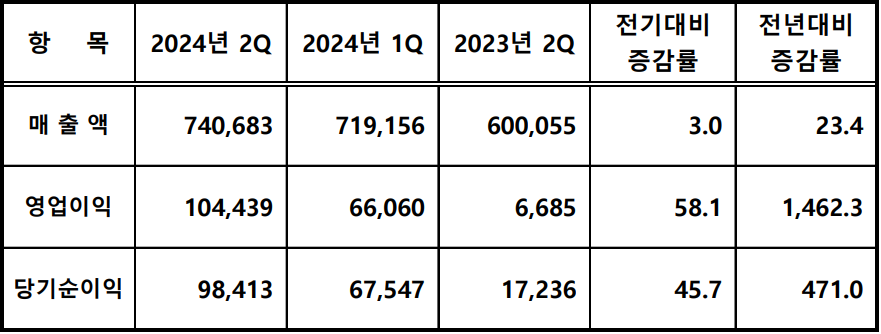삼성전자 2024년 2분기 경영실적이 메모리 반도체의 호전에 힘입어 호실적을 거뒀다. 연결재무제표 기준으로 매출은 74조683억원을 기록해 전년동기대비 23.4% 증가했고, 영업이익은 10조4,439억원으로 전년동기대비 1,462.3% 증가했다. 당기순이익은 9조8,413억원으로 전년동기대비 471% 증가했다.

▲삼성전자 2024년 2분기 경영실적(단위 : 억원,%)
반도체 영업익 6조5천억, 메모리 대폭 호전
하반기 AI 수요 집중, DDR5·SSD·HBM 확대
삼성전자 2024년 2분기 경영실적이 메모리 반도체의 호전에 힘입어 호실적을 거뒀다.
삼성전자는 31일 2024년 2분기 경영실적을 공시했다. 이에 따르면 연결재무제표 기준으로 매출은 74조683억원을 기록해 전년동기대비 23.4% 증가했고, 영업이익은 10조4,439억원으로 전년동기대비 1,462.3% 증가했다. 당기순이익은 9조8,413억원으로 전년동기대비 471% 증가했다.
DS(Device Solutions)부문은 매출 28조5,600억원, 영업이익 6조4,500억원을 기록했다.
메모리는 생성형 AI 서버용 제품의 수요 강세에 힘입어 △DDR5 △서버SSD △HBM(High Bandwidth Memory) 등 실적이 대폭 호전됐고, 파운드리는 5나노 이하 선단 공정 수주 확대로 고객수가 약 2배로 증가했다.
DX(Device eXperience)부문은 매출 42조700억원, 영업이익 2조7,200억원을 기록했다.
MX(Mobile eXperience)는 2분기 스마트폰 시장 비수기가 지속되면서 매출이 신모델이 출시된 1분기에 비해 감소했다. 판매호조가 지속되고 있는 S24 시리즈는 2분기와 상반기 출하량·매출 모두 전년 대비 두 자릿수 성장을 달성했다.
VD(Visual Display)는 글로벌 대형 스포츠 이벤트 특수에 힘입어 선진 시장 성장을 중심으로 전년 대비 매출이 상승했다.
하만은 매출 3조6,200억원, 영업이익 3,200억원을 기록했다.
SDC는 매출 7조6,500억원, 영업이익 1조100억원을 기록했다. 디스플레이는 중소형 패널의 경우 플래그십 제품의 견조한 수요와 리지드(Rigid) 판매 기반 강화로 전분기 대비 판매량이 증가하여 실적이 개선됐다.
2분기 시설투자는 12조1,000억원으로 DS 9조9,000억원, 디스플레이 1조8,000억원 수준이다. 전분기대비 8,000억원 증가한 것이다.
하반기 전망과 관련해서는 메모리는 주요 클라우드 서비스 공급자와 일반 기업체의 AI 서버 투자가 확대됨에 따라 시장 내 AI 서버 구축을 위해 HBM·DDR5·SSD 등 서버용 메모리 제품의 수요 강세가 지속될 것으로 전망된다.
시스템LSI는 플래그십 제품용 엑시노스 2500의 안정적 공급을 위해 사업부 역량을 집중할 계획이다. 업계 최초 3나노 SoC가 적용된 웨어러블 제품의 초기 시장 반응이 호조를 보이고 있고, 하반기 주요 거래선의 SoC 채용 모델 확대가 예상된다.
파운드리는 모바일 제품군의 수요 회복세에 따라 AI와 고성능 컴퓨팅 분야 제품 수요가 증가할 것으로 예상된다. 선단 노드 중심으로 시장이 성장할 전망이다.
삼성전자는 선단 공정 사업 확대와 GAA 3나노 2세대 공정 본격 양산을 통해 올해 시장 성장률을 상회하는 매출 신장을 기대하고 있다. 하반기에도 AI와 고성능 컴퓨팅 분야 수주를 지속 확대할 계획이다.
MX는 AI 수요 확대와 신규 폼팩터 제품 출시 등에 힘입어 프리미엄 제품을 중심으로 시장 성장세를 견인할 것으로 전망된다.
VD는 프리미엄 제품의 수요 성장과 대형화 트렌드 지속으로 전체 TV 시장 수요가 회복될 것으로 전망되는 가운데 Neo QLED와 OLED 등 주력 제품 판매를 중심으로 시장 성장세를 주도할 계획이다.
하만은 전장 부문 신규 분야 수주 확대를 통해 사업 역량을 강화할 예정이고, 디스플레이는 중소형의 경우 주요 고객사의 신제품 출시와 최근 증가 중인 AI 스마트폰 교체 수요로 판매 확대가 기대되지만, 업체 간 경쟁은 상반기보다 심화할 전망이다.